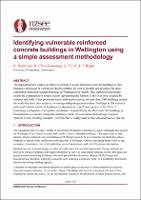| dc.contributor.author | Balbirnie, Kieran | |
| dc.contributor.author | Chandramohan, Reagan | |
| dc.contributor.author | Pujol, Santiago | |
| dc.contributor.author | Wright, Joshua | |
| dc.date.accessioned | 2021-06-22T04:01:54Z | |
| dc.date.available | 2021-06-22T04:01:54Z | |
| dc.date.issued | 2021-04-14 | |
| dc.identifier.uri | https://repo.nzsee.org.nz/xmlui/handle/nzsee/2368 | |
| dc.description.abstract | The application of a simple yet effective method to assess reinforced concrete buildings in New Zealand is discussed. It is proposed that this method be used to identify and prioritise the most vulnerable reinforced concrete buildings in Wellington for retrofit. This method of assessment entails the computation of simple indices representing the fraction of the floor area occupied by columns and walls. It has previously been calibrated to surveys of more than 1000 buildings around the world that have been subjected to strong earthquake ground motion. Buildings in Christchurch with small column and/or wall indices are shown to have performed poorly in the 2010-11 Canterbury earthquakes. The method would have helped identify the PGC and CTV buildings in Christchurch as critically vulnerable structures, while the assessment methodology based on “percent of new building standard” (%NBS), that is widely used in New Zealand practice, did not. | |
| dc.language.iso | en | |
| dc.publisher | New Zealand Society for Earthquake Engineering | |
| dc.relation.ispartofseries | 2021;0143 | |
| dc.subject | Case studies and research supporting mitigation by retrofitting | |
| dc.title | Identifying vulnerable reinforced concrete buildings in Wellington using a simple assessment methodology | |
| dc.type | Article | |

